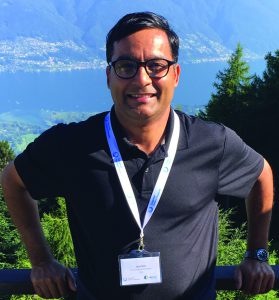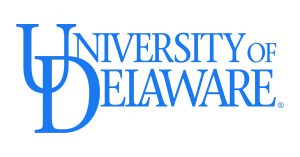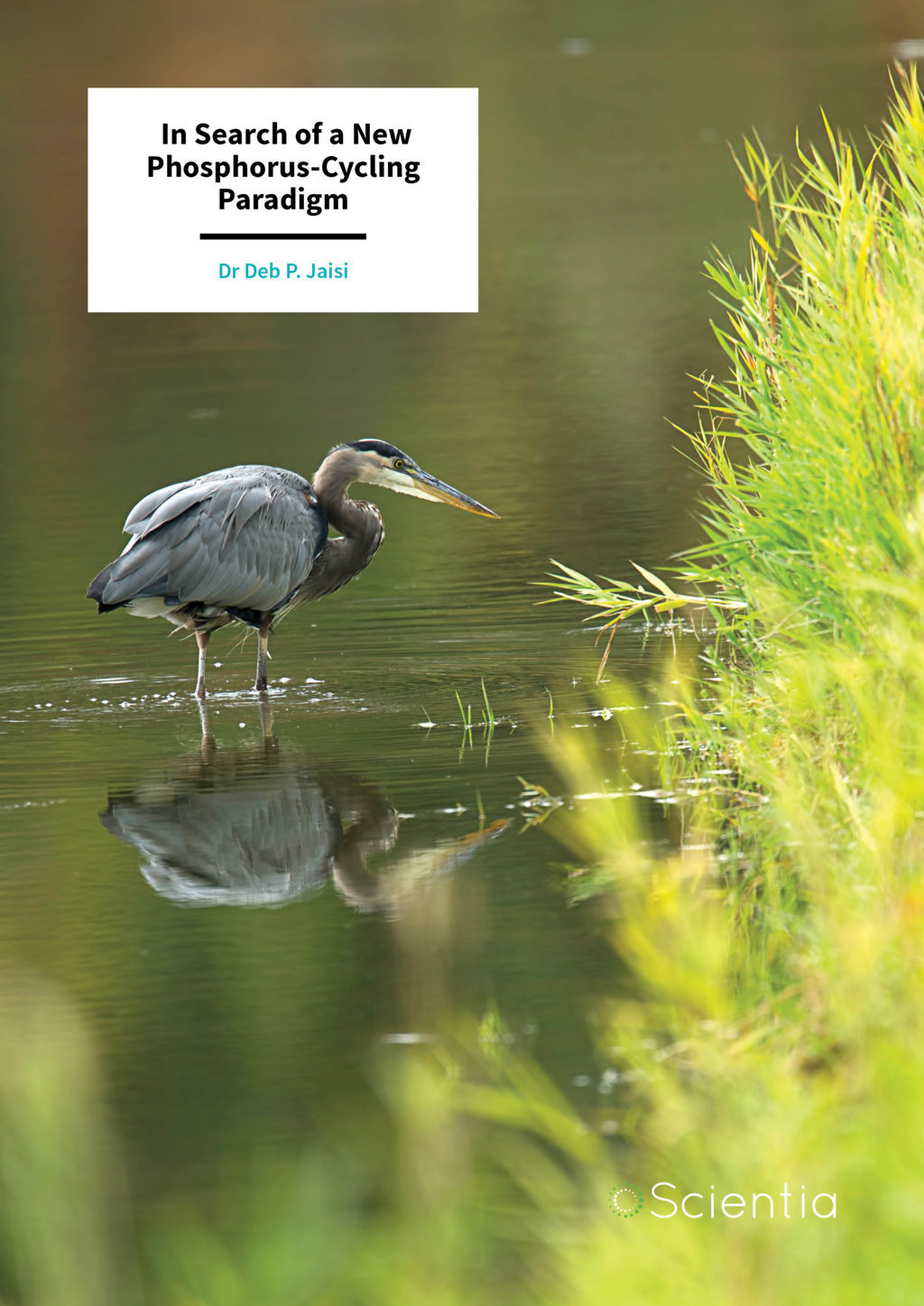Professor Deb Jaisi – In Search of a New Phosphorus-Cycling Paradigm
Phosphorus poses a modern-day dilemma. On one hand, it is an essential nutrient for all plants and animals and is undisputedly indispensable as a crop fertiliser. On the other hand, its wide use in agriculture has been blamed for polluting waterways. Phosphorus is also becoming scarcer, so clearly a new approach is needed for its management. Associate Professor Deb Jaisi and his team at the University of Delaware are developing novel ways to track phosphorus as it moves and transforms through the environment. Their findings are already changing some long-held assumptions.
The Peculiarity of Phosphorus
Phosphorus is an essential element. It’s found in our bones and is a key component of adenosine triphosphate, or ATP, our cells’ energy source. We acquire phosphorus by eating plants or other animals that eat plants, which absorb phosphorus from the soil. Phosphorus in the soil either originates from the decomposition of plants and animals, the weathering of rocks, or is externally applied for plant growth.
In today’s world, however, we mostly eat plants, or crops, that have been grown in intensely-farmed fields. Crops deplete the soil of so much natural phosphorus that it has to be mined from elsewhere and added to the soil as fertiliser. This is where our modern-day problem with phosphorus begins.
As it is, humans are mining and moving phosphorus in ways that are interrupting its natural cycle. ‘The world today is a more challenging place than before in many dimensions – one being the disproportionate distribution of phosphorus,’ says Dr Deb Jaisi of the University of Delaware. Dr Jaisi and his research team are keenly interested in how phosphorus transforms and transfer from soils to waters, especially given the problems it poses.
One problem is that phosphorus (or P) is that it is a non-renewable resource. It’s mined from phosphate rock, which is only found in a limited number of reserves. Morocco and the Western Sahara account for around 75% of the world’s total phosphate reserves, while Florida in the United States accounts for most of the rest. The limited availability of this resource means that factors such as political instability can disrupt the global supply at any time.
‘Our findings will make meaningful contributions to the goal of maintaining healthy ecosystems and water quality, while at the same time achieving sustainable agricultural production – which is central to meeting the water, energy, and food security demands of a growing global population.’
There is no substitute for phosphorus, especially in its important use as a fertiliser. ‘The natural reserves of phosphorus are alarmingly declining and the supply of fertilisers for future crop production has been an even more pressing question,’ expresses Dr Jaisi.
Along with its growing scarcity, another problem is that phosphorus is a major source of water pollution. Plants need a high amount of phosphorus to grow, but if a small amount of phosphorus is lost to open waters, that is sufficient to cause water quality problems. This is because a limited amount of dissolved phosphorus can significantly boost the growth of algae and aquatic plants in surface waters, which in turn depletes oxygen and causes larger organisms such as fish to die in deeper waters. These undesirable conditions, known as ‘eutrophication’ at the surface water and ‘dead-zone’ in bottom waters, have always been blamed on excess phosphorus and nitrogen originating primarily from agricultural lands. However other sources such as sewage and geological sources could also be a source of phosphorus pollution.
The issues of dead zones and eutrophication, especially in waterways such as the Chesapeake Bay and the Gulf of Mexico, have been mulled about for decades. ‘These problems have attracted media attention for decades and are still continually highlighted in news stories and reports to highly significant scientific bodies such as US National Academy of Sciences and policy bodies such as scientific report to the White House,’ says Dr Jaisi.
However, he thinks that the old ways and methods of looking at the problem aren’t going to generate useful results that may lead to effective strategies for cleaner waterways. ‘Ironically, classical methods used in phosphorus research cannot resolve these questions,’ he says. Dr Jaisi explains that we instead need to move onto new analytical methods that are specific and can identify and connect phosphorus sources and processes.
Dr Jaisi has made understanding phosphorus the goal and focus of his research ever since he became aware of the environmental problem it poses. ‘I am passionate about breaking the technological barriers and develop and apply novel methods – that bring benefit both to science and society,’ he says.

Environmental Biogeochemistry Laboratory
Dr Jaisi pursues his passion and leads the Environmental Biogeochemistry Laboratory (EBL), located in Newark, Delaware. EBL has both an analytical biogeochemistry and a stable isotope geochemistry facility, the latter boasts state-of-the-art instruments and equipment. Since 2011, Dr Jaisi and his team have received $5.5 million in funding from a mix of federal funding bodies (USDA, NSF and USGS), professional organisations, and private sources.
The team uses stable isotopes fingerprint to trace and mark phosphorous as it is added to soils and is then lost to the ground and surface water. They also use isotopes to distinguish between different generations of so-called legacy phosphorus. Legacy phosphorous refers to the build-up of phosphorous in soil over time due to the constant application of manure and fertiliser in excess of plant needs. As of now, available research tools to discriminate legacy phosphorous and address the issue of their fate are essentially null. This means that the role of legacy phosphorus is approximated.
Dr Jaisi is keenly interested in the fate of organic phosphorus compounds, as some of them are highly potent for water quality issues and others are present in pesticides. For example, phytate is a naturally-occurring organic phosphorus compound found in plant seeds and can account for a high amount (40–55%) of the total phosphorous in fertilised agricultural soils. Contrary to the ‘common wisdom’ that phytate and its daughter products are relatively inert, Dr Jaisi’s team found that it is much more reactive than previously thought and are in the forefront on developing methods to track these chemicals in the environment.
Dr Jaisi recently received an NSF CAREER award to undertake research into the fate of phytate in the environment. Another compound of interest for research is glyphosate, a widely used herbicide (known as Roundup to almost every gardener in the US or UK). On the plus side, glyphosate is effective and inexpensive. However, its toxicity and mobility in the environment are questioned by the public and policy makers. Dr Jaisi and his collaborators are using advanced research tools, including stable isotopes and computational modelling, to identify the sources of this herbicide and its pathway of degradation in the environment. Dr Jaisi believes that the mechanistic understanding of degradation recently generated may open up possibilities to ‘bias’ the degradation to safer product pathways or could be used to design safer herbicides.

The Chesapeake Bay Studies
Dr Jaisi’s most important field site – the Chesapeake Bay – is literally in his back yard. It is the US’s biggest and most productive estuary that is also located in a densely populated and politically sensitive area – next to Washington DC. As such, it has suffered years of runoff and pollution from agriculture, farming, industry and general urbanisation. Eutrophication issues and dead zones abound and very little achievement in water quality achieved so far in the Chesapeake.
For the last few years, Dr Jaisi and his team have set out to map and better understand phosphorous-cycling in the Chesapeake Bay – both recycling within the Bay and incoming from land sources through rivers. Using their novel methods with stable isotopes, they are shedding new light on where phosphorous comes from and how it impacts water quality.
One of their studies, published in 2015 in the Soil Science Society of America Journal, focused on East Creek, a tributary on the eastern shore of the Chesapeake Bay. This creek drains runoff primarily from agricultural fields and poultry operations for years, causing it to have a significant build-up of soil and legacy phosphorous. Their study identified the major factors that influence how much phosphorous is actually mobilised downstream into the Chesapeake Bay. These results were highlighted in the CSA news magazine. In follow up studies on this creek, the team has evaluated the roles of the tide on diluting and removing phosphorous from the upstream region of the creek. Similarly, combining isotope signatures with element fingerprinting has allowed the team to understand source and function of phosphorus regarding its impact on water quality.
A major research focus of Dr Jaisi’s team involves the Chesapeake Bay itself. For the first time ever, these scientists demonstrated that the decay of organic matter – a process known as remineralisation – was the predominant pathway of phosphorous-cycling in the Chesapeake Bay. They were able to trace the isotopic signature of phosphorous after remineralisation and discriminate this from external phosphorus sources that are exported to the Bay, providing strong evidence on the role of internal cycling on water quality, something that has also never been previously reported. This finding was highlighted in 2015 in the cover page of the journal Environmental Science & Technology and several other news outlets including UDaily news and US DOE National Laboratory.
Most recently, Dr Jaisi’s team has launched a multi-year study that involved collecting water and suspended particles at several sites in the Chesapeake Bay and in the Susquehanna River. The sites are meant to represent external input sources, gradients of river estuaries and freshwater versus brackish waters. By connecting phosphorus sources and cycling, the team will attempt to link summertime eutrophication with hypoxia in the main channel.
As part of this study, Dr Jaisi and his colleagues have been able to demonstrate again that remineralisation is a significant source of dissolved phosphorous in the water column in the Chesapeake Bay. They found that more phosphorous comes from the remineralisation of suspended organic matter, such as phytoplankton. Interestingly, they discovered that iron-bound phosphorous is more inert and largely deposited in the sediment column, while preserving its land-source isotope signatures. By looking at phosphate oxygen isotope ratios, the team was able to identify both terrestrial input and organic remineralisation as major sources of phosphorous in the Bay. These findings were published in 2017 in AGU’s Journal of Geophysical Research.

A Better Toolbox
Dr Jaisi’s findings on the ways in which phosphorous cycles in the Chesapeake Bay are shaking up paradigms. For years, the eventual fate of phosphorus leaching from agricultural fields and other sources, and its impacts on water quality, have remained and are hotly debated by the public and policy makers. Understanding how particular sources of phosphorus or particular processes are responsible for causing eutrophication and dead zones in the Chesapeake Bay is an area where Dr Jaisi’s team has made significant contributions.
‘Our work, in various dimensions from the molecular to ecosystem levels, should have profound implications for how to control nutrient over-loading in the future, especially given the high price tags associated with clean-up today,’ says Dr Jaisi. ‘What is important to look carefully is the cost of improving water quality. For example, economic benefits provided by the Chesapeake Bay watershed are calculated to be ~$130 billion annually if the Chesapeake Clean Water Blueprint is fully implemented but this comes with a hefty price tag of $5 billion annual expenditure for its clean-up.’
The team will continue to hone and tweak their procedures as they study how phosphorous behaves. ‘We are using, revising and developing the toolbox of advanced and innovative analytical methods which go beyond operationally defined phosphorous pools and are able to access phosphorous structural information and then connect structure to chemical reactivity, sources, and pathway of transformation,’ Dr Jaisi explains.
With good reason, he adds, ‘our findings will make meaningful contributions to the goal of maintaining healthy ecosystems and water quality, while at the same time achieving sustainable agricultural production – which is central to meeting the water, energy, and food security demands of a growing global population.’
Meet the researcher

Dr Deb P. Jaisi
Department of Plant and Soil Sciences
University of Delaware
Newark, DE
USA
Dr Deb Jaisi is currently Associate Professor of Environmental Biogeochemistry in the Department of Plant and Soil Sciences at the University of Delaware. Much of his academic career relies on training and research experience in isotope geochemistry at Yale University. At the University of Delaware, Dr Jaisi heads the Environmental Biogeochemistry Laboratory (EBL), which focuses on phosphorous cycling in both soils and waterways. EBL is home to state-of-the-art facilities for measuring and analysing biogeochemical and isotopic processes from the nano- to ecosystem- levels. Since 2011, he received about 5.5 million US dollars in funding for his research programs. Most notably, Dr Jaisi received the National Science Foundation’s CAREER award in 2016. He is a member of the American Geophysical Union and the American Chemical Society, among other professional organisations. He is an associate editor of Clays and Clay Minerals and editorial board member of two journals, ACS Earth and Space Chemistry and Soil Methods. He has published over 52 peer-reviewed papers and book chapters and has given several keynote presentations in professional society meetings, state and local government bodies.
CONTACT
E: jaisi@udel.edu
T: (+1) 302 831 1376
W: http://sites.udel.edu/ebl
FUNDING
US Department of Agriculture (USDA)
National Science Foundation (NSF)
American Chemical Society (ACS)
US Geological Survey (USGS)
REFERENCES
J Li, P Reardon, JP McKinley, SR Joshi, Y Bai, K Bear, DP Jaisi, Water column particulate matter: A key contributor to phosphorus regeneration in a coastal eutrophic environment, the Chesapeake Bay, Journal of Geophysical Research: Biogeosciences, 2017, doi: 10.1002/2016JG003572.
J Li, Y Bai, K Bear, S Joshi, D Jaisi, Phosphorus availability and turnover in the Chesapeake Bay: Insights from nutrient stoichiometry and phosphate oxygen isotope ratios. Journal of Geophysical Research: Biogeosciences, 2017, doi:10.1002/2016JG003589.
K Upreti, SR Joshi, J McGrath, DP Jaisi, Factors controlling phosphorus mobilization in a Coastal Plain tributary to the Chesapeake Bay, 2015, Soil Science Society of America Journal, 79, 826–837.
SR Joshi, RK Kukkadapu, DJ Burdige, ME Bowden, DL Sparks, DP Jaisi, Organic matter remineralization predominates phosphorus cycling in the mid-bay sediments in the Chesapeake Bay, Environmental science & technology, 2015, 49, 5887–5896.


